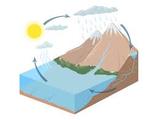Science: Water Cycle
Standard 1: Students will understand that water changes state as it moves through the water cycle.
Objective 1: Describe the relationship between heat energy, evaporation and condensation of water on Earth.
Objective 2: Describe the water cycle.
Standard 1: Students will understand that water changes state as it moves through the water cycle.
Objective 1: Describe the relationship between heat energy, evaporation and condensation of water on Earth.
- Identify the relative amount and kind of water found in various locations on Earth (e.g., oceans have most of the water, glaciers and snowfields contain most fresh water).
- Identify the sun as the source of energy that evaporates water from the surface of Earth.
- Compare the processes of evaporation and condensation of water.
- Investigate and record temperature data to show the effects of heat energy on changing the states of water.
Objective 2: Describe the water cycle.
- Locate examples of evaporation and condensation in the water cycle (e.g., water evaporates when heated and clouds or dew forms when vapor is cooled).
- Describe the processes of evaporation, condensation, and precipitation as they relate to the water cycle.
- Identify locations that hold water as it passes through the water cycle (e.g., oceans, atmosphere, fresh surface water, snow, ice, and ground water).
- Construct a model or diagram to show how water continuously moves through the water cycle over time.
- Describe how the water cycle relates to the water supply in your community.
Assignments
Resources
Videos
|
|
|


